External Sector
Non Resident Keralites
Non-Resident Keralites play a significant role in the progress of the state. Their contribution to the development can be seen at the household-level, community-level and state/country-level. There have been improvements in household earnings, food, consumption, health care, housing and educational attainments. For over three decades, remittances have also been meeting the current account deficit of the Indian economy.
The destinations of emigrants from Kerala are spread across the world. The Kerala Migration Survey 2014 (draft), conducted by the Centre for Development Studies, estimated that there were more than 24 lakh Keralites living in various countries and their remittances to the state net domestic product was nearly 36.5 per cent. The average age of emigrants was 24.74 years. Educational profiles of the emigrants were better than of the general population; 75.1 per cent had passed Class 10, and 35.4 per cent had received diploma or a degree or higher levels of education. Figure 6.3 shows the district wise proportion of emigrants from Kerala.
Figure 6.3
District wise proportion of emigrants from Kerala, in per cent
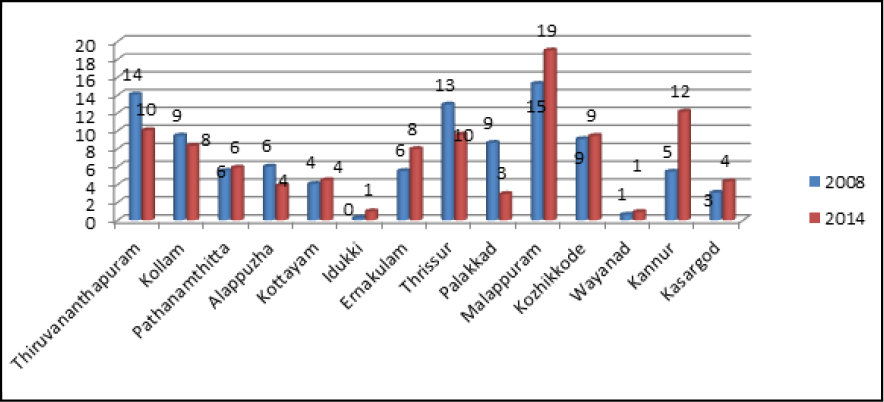
Source: Kerala Migration Survey, 2014 (Draft), State Planning Board, GoK.
Between 2008 and 2014, the number of emigrants declined drastically in some districts, while in others, including hilly regions, the number of emigrants significantly increased. In the Southern districts, such as Thiruvananthapuram, Kollam and Alappuzha, the rate of growth of emigrants declined by 21.6 per cent, 3.7 per cent and 29.3 per cent respectively between 2008 and 2014. In absolute terms, the number of emigrants declined by 66,754 in Thiruvananthapuram, 7,583 in Kollam and 38,623 in Alappuzha. Districts registering significant increase were Pathanamthitta, Ernakulam, Idukki and Kannur. Details are in Appendix 6.5.
If we consider the number of migrants per 100 households, the figure was highest for Malappuram district. In 2014, per 100 households, there were 54 emigrants in Malappuram and 50 emigrants in Kannur. The lowest number of emigrants per 100 households was reported in Idukki, Wayanad and Palakkad (Figure.6.4).
Figure 6.4
Emigrants per 100 Households

Source: Kerala Migration Survey, 2014 (Draft), State Planning Board, GoK.
Return Emigrants
Due to the nationalisation policy in the Middle East countries and economic destabilisation all over the world, the number of return emigrants is increasing in Kerala. The total number of return emigrants increased from 7.3 lakh in 1998 to 12.5 lakh in 2014. Figure 6.5 shows the increasing trend of return migrants in Kerala.
Figure 6.5
Number of Return Emigrants in Kerala
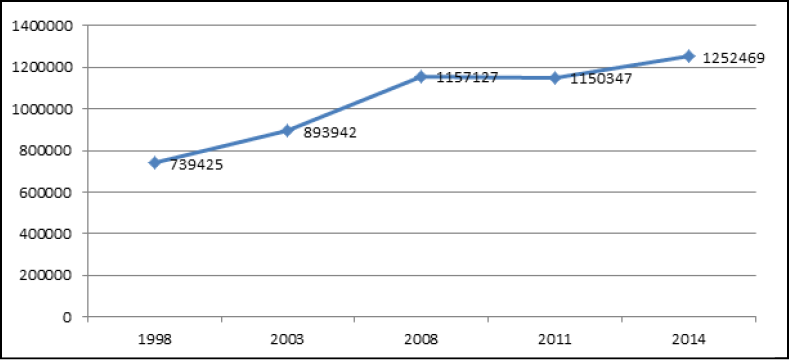
Source: Kerala Migration Survey, 2014 (Draft), State Planning Board, GoK.
A district-wise analysis shows that Malappuram accounted for 24 per cent of the total return emigrants in Kerala followed by Thiruvananthapuram and Kollam with 17 per cent and 10 per cent shares respectively. Figure 6.6 shows the district-wise proportion of return emigrants in Kerala for 2008 and 2014. Detailed data on district-wise number of return emigrants is given in the Appendix 6.6.
Figure 6.6
District wise proportion of Return Migrants to Kerala, in per cent
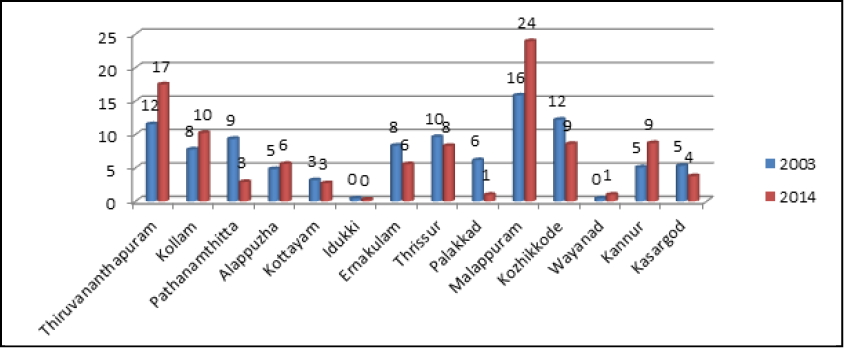
Source: Kerala Migration Survey, 2014 (Draft), State Planning Board, GoK.
Number Of Working NRKs
Out of the total Non-Resident Keralites, 87.77 per cent are engaged in economic activities. Among those employed, 93.04 per cent are men and 6.96 per cent are women. Among all districts, Malappuram has the highest proportion of NRK's employed at 19.51 per cent, followed by Thrissur and Kozhikode at 10.50 per cent and 10.37 per cent respectively. The district- and sex-wise ratio of working NRKs are given in Appendix 6.7.
Figure 6.7
District-wise working NRKs in Kerala

Source: Economics and Statistics Department, GoK.
Destination Of Emigrants from Kerala
A country-wise destination analysis of emigrants from Kerala shows that 37.5 per cent of the emigrants are in the UAE and 21.8 per cent are in Saudi Arabia. Out of the total emigrants, 86.3 per cent reside in West Asia. Emigrants residing in the U.K, Canada and South-East Asian countries are increasing over the years. Figure 6.8 shows the country-wise destination of total emigrants from Kerala for the period 2008 and 2014.
Figure 6.8
Country wise destination of Emigrants from Kerala
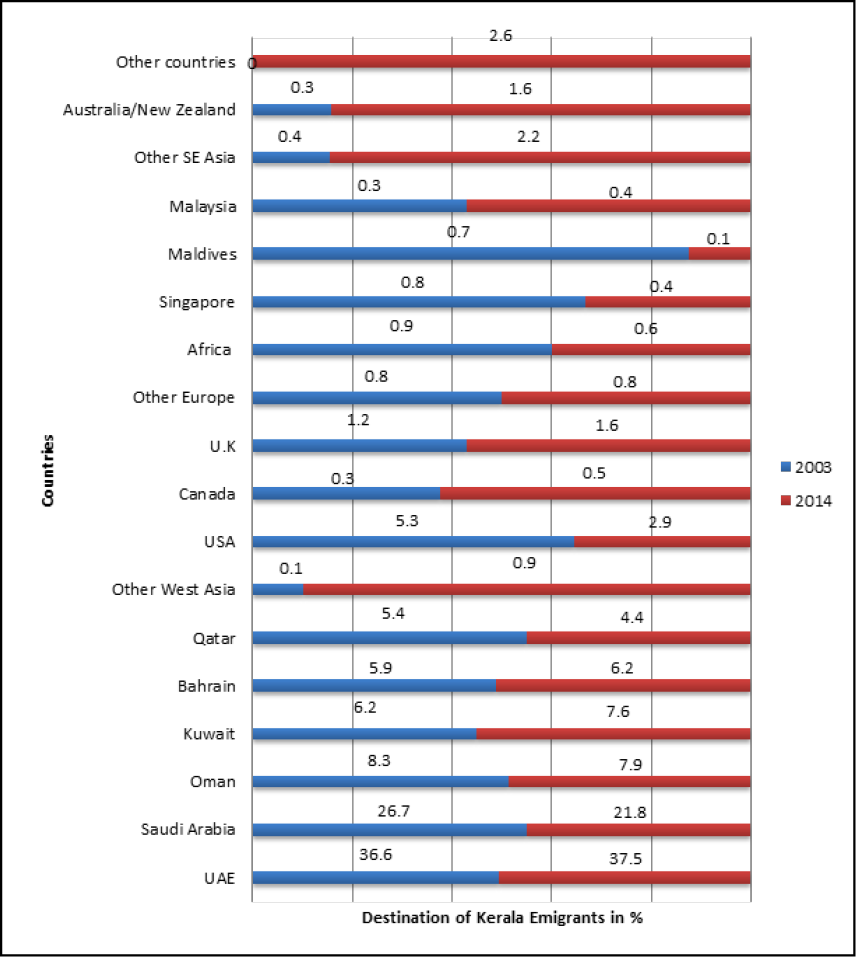
Source: Kerala Migration Survey, 2014 (Draft), State Planning Board, GoK
Profession-Wise NRKs
In recent years, the pattern of emigration has changed in respect of job seeking. In the 1970s, the proportion of skilled workforce in the total emigrants was very small. Over the years, the share of skilled workforce within total emigrants, such as from professions like doctors, nurses, engineers, IT professionals, and teachers has increased. Distribution of NRK's by profession showed that 11.85 per cent worked as drivers, 10.99 per cent worked as salesmen, 6.37 per cent worked as nurses, 3.78 per cent worked as engineers, 2.23 per cent worked as IT professionals and 0.53 per cent worked as doctors. The remaining 64.25 per cent worked as businessman, teachers, bank professional and other workers.
Among the doctors, the highest share is reported from Thiruvananthapuram at 14.39 per cent followed by Kottayam and Ernakulam at 14.38 per cent and 14.34 per cent respectively. The lowest share is from Wayanad. In the case of nurses, the highest proportion is from Kottayam at 23.73 per cent followed by Pathanamthitta at 20.75 per cent and Ernakulam at 18.16 per cent. Among engineers, Ernakulam has the highest proportion of 13.47 per cent, followed by Thrissur at 13.23 per cent and Kottayam at 10.11 per cent. Among teachers, Pathanamthitta has the highest share of 16.69 per cent followed by Alappuzha at 15.99 per cent and Kottayam at 9.74 per cent. Figure 6.9 shows the district wise number of NRKs working in different jobs abroad.
Figure 6.9
District-wise NRKs working in different jobs
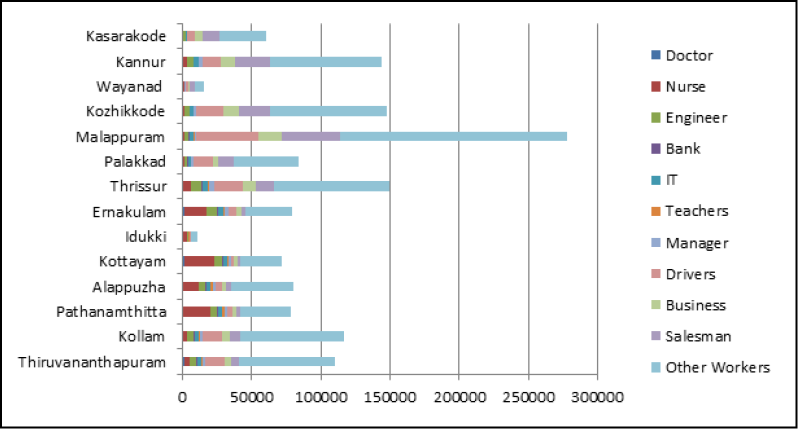
Source: Economic and Statistics Department, GoK.
Working Group on NORKA
As part of the formulation of the 13th Five Year Plan, a Working Group on NORKA was constituted under the Co-Chairpersonship of Dr. Usha Titus IAS, former Secretary to NORKA Department, Government of Kerala and Prof. S. Irudaya Rajan, Professor, Centre for Development Studies, Thiruvananthapuram. Terms of reference of the Working Group was to i) critically assess the existing data base on migration and review the available estimates on the number and composition of Non- Resident Keralites (NRKs) and to propose a comprehensive methodology for collection and constant renewal of the information base on NRKs; ii) to analyse the impact of out migration on various dimensions of life in Kerala with special focus on economic and social implications; iii) to assess the implications of de-territorialisation of the Kerala economy and to suggest ways of promoting integrated development of Keralites within and outside the borders of the state; iv) to examine the evolution of emigration policy of India in a comparative perspective and propose changes that are required; v) to critically review all government programmes/schemes, especially those initiated by the state government during 11th and 12th plan periods and suggest a comprehensive approach towards migration and migrants that would maximize the welfare of the migrants as well as the home state; vi) to identify leading issues, such as rehabilitation and NRK investment in Kerala, that call for immediate government intervention and help formulate innovative programmes to be taken up during the 13th plan; and vii) to identify and formulate a set of output and outcome indicators (preferably measurable) for the sector and base the analysis of the previous plans on these indicators. Members of the Working Group comprised of administrators, academics, experts and representatives of Non-Resident Keralites from abroad. The report will be published shortly.
A glimpse of Plan Schemes, Services and Projects offered by Norka Roots
Rehabilitation of Return Migrants:The aim of the scheme is to reintegrate returned emigrants by helping them find suitable employment/self-employment as a step towards the rehabilitation of return migrants. The government has established NORKA Department Project for Return Emigrants (NDPREM) to develop a sustainable business model. The project envisages providing a capital subsidy of 10 per cent of the total project cost as a backend subsidy to eligible entrepreneurs among return emigrants who wish to start their own ventures in the field of agri-business, training, services and manufacturing.
Santhwana: This scheme provides financial assistance to NRKs (returnees) whose minimum period of service abroad is two years. The period after return should not exceed 10 years. For medical assistance Rs. 50,000 is provided. The ceiling for death assistance is Rs. 100,000, for marriage assistance is Rs. 15,000 and for wheel chair crèches and artificial limbs is Rs. 10,000.
SwapnaSaphalyam: The lower segments of Non –Resident Keralites working abroad, especially in Gulf countries, are subjected to various miseries due to lack of labour protection rules. It is estimated that 1400 Indians are jailed in Saudi Arabia alone, of which 80 per cent are NRKs. The scheme proposes to address NRKs jailed abroad for no wilful default on their part and aims to provide free air tickets when they are released from jails, in case they are not able to afford the tickets.
Pravasi Legal Assistance (Pravasi Legal Aid Cell): One of the major problems faced by the migrant workers from Kerala to the Middle East is the court cases and other legal problems they get embroiled in. In the absence of any legal help, the poor workers end up in the jail. This happens even in cases of minor offence or sometimes without any offence. The government proposes to extend legal assistance, including appearance in courts abroad, through the Indian Diplomatic Missions or through advocates empanelled by the Indian Mission.
24 Hours Help Line/Call Centres: The scheme intends to disseminate information on various schemes/projects implemented by the government and NORKA ROOTS, redress grievances of NRKs, conduct counselling to NRKs who are in distress, create awareness among emigrants and prospective emigrants against illegal exploitation, migration and act as a frontline service facilitator/one point client interaction point for NRKs. It is also envisaged to provide need-based information and assistance to emigrants through the proposed helpline.
Pre-Departure Orientation Programme: The general public lacks awareness in matters connected with emigration in general and overseas jobs in particular. The scheme intends to impart orientation and training to these prospective emigrants before departing to their destination countries so as to ensure legal migration. The widespread rural penetration of this scheme will limit prevailing illegal migration and exploitation by unscrupulous recruiting agents.
The green shoots of revival in exports have provided an optimism for boosting up trade in the economy. The country needs to formulate policies and strategies to boost exports which are the only sustainable way in India's international trade environment. The State also needs to take proactive steps and address the impediments and gaps affecting the sector. Diversification of markets, certification, packing and labeling needs to be focused. An export strategy needs to be formulated. The State's development frontiers extend much beyond its geographical boundaries as a major share of its population resides outside the state. The State needs to come up with innovative solutions to improve the efficacy of existing programs, devise appropriate and clear recruitment strategy and involve the NRKs in spearheading states' economic development through harnessing their capabilities.

